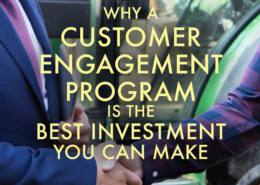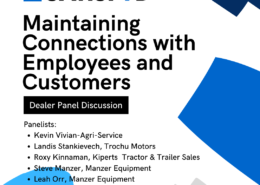4 Best Practices for a Successful Customer Experience Management Program
According to the Tempkin Group, “Loyal customers are seven times as likely to test an offering, five times as likely to buy again and four times as likely to refer.” But how do you build customer loyalty and create these ‘loyal customers’? By defining and incorporating your organization’s Customer Experience Management expectations and processes. To help you drive growth, we recommend you incorporate these 4 best practices for a successful customer experience management program.
A People Plan
A What?
Your employees are the key to delivering on your brand promise. The quality of their work, customer interactions, and how they represent your organization has a direct impact on your ability to grow your customer base. It’s important to create a plan for getting your people not only on board with a Customer Experience Management program but foster a culture that creates loyal customer advocates to guarantee success.
How?
When creating your “People Plan” include 2 key aspects proven to motivate and engage your employees. Define how you will get everyone involved in the process and determine how to continually keep them in the loop. By doing so, everyone will be on the same page and you will present a one-company image of putting customer experiences first. Here are some ideas for making your people plan an ongoing success:
Get employees involved in the process
- Offer your employees an opportunity to develop and contribute ideas. By making them feel appreciated and part of the organization, you will increase employee engagement, create loyal customers and drive growth.
- Let your employees know you value their thoughts and ideas. Let staff come up with customer facing issue resolutions since they are closest to the customer. Be sure to ask employees what they are hearing and create employee focus groups that meet regularly.
- Give recognition when an employee raises the bar and reinforces the customer-first culture. You can do this by a shout out at weekly or monthly meetings and in the company newsletter. Catch employees doing things right.
- Find an opportunity to use the insights collected as part of a reward or recognition program.
- Integrate customer experience initiatives into performance reviews and show how employees’ work impacts the company goals. Collaborate to set both future goals and how progress will be measured.
Continually keep employees in the loop
- Align policies and training to create an empowered, customer-first mentality. Continually create and update job aids and training modules and make them available to assist employees during customer interactions. Make sure your employees know these are always available and updated for new issues and encourage them to review monthly.
- Share company news, customer experience scores and performance measurements each month, letting everyone see the impact of their customer and employee interactions. Share all returned customer surveys and monthly customer experience scores with staff.
- Read more about the impact of keeping employees in the loop by clicking here.
A Closed Loop Process Plan
A What?
A “closed loop” process happens when you include your customer in the issue resolution process. When a customer supplies your organization with feedback, you start the loop by working to understand their concern and analyzing the issue for possible solutions. Discussions with responsible team members and the customer will determine both the solution and a strategy for preventing future recurrence. You close the loop by establishing a plan to address/prevent future occurrences and resolving the issue with the current customer.
Listening to your customers and managing their issues is an important competitive differentiator in today’s market. By taking the time to learn how to improve an experience, you gain two important advantages: You show your customers that their needs are a priority, and learn firsthand how to implement changes to improve their experience.
How?
This can be a lot of work, especially as your business starts to grow. Make it easier to manage and close the loop by incorporating a customer feedback tool (hint hint: SATISFYD) into your issue management process. You’ll be notified automatically when issues arise, have an electronic record of the decisions and steps you took, and successfully close the loop with every customer.
Here are some best practices on how to close the loop more efficiently:
- Contact customers with issues within 24 hours of receiving feedback. Top dealers know that a timely response is crucial for retaining future business.
- Clearly document the root cause and issue resolution to prevent future recurrence. By tracking the steps for issue resolution, dealerships can update processes quickly to improve future customer experiences. Read 8 Steps for Implementing a Customer Resolution Processes.
- The amount of time it takes to resolve issues will vary by dealership, location, and department. Set clear goals to close out issues in a short amount of time, and establish regular communications with customers whose issues cannot be resolved within that timeframe.
A Plan for Preventing Future/Repetitive Issues
A What?
With technology and expectations ever evolving, the way an issue was resolved 10 years ago will be much different than it is today. It’s important to have a process in place that addresses how your organization will prevent repetitive and future issues. Repetitive issues are a signal to take action. While you may have a plan in place to resolve that issue moving forward, wouldn’t it be better (if possible) to find a way for that issue to not occur at all?
How?
Take a brave step and complete a comprehensive review of your processes from your customers’ perspective. Commit to analyzing an issue’s root cause if it occurs a certain number of times. Be sure to include solutions offered by your customer facing employees to encourage continuous improvement and customer focused action.
Some best practices shared by dealers on how they prevent future issues include:
- Bring together a group of employees that can brainstorm to find the best solutions to resolve the issue. Employees may be from one department or across departments/locations.
- Describe the problem in as much detail as possible using input from both the customer and employees in order to produce the best possible outcome. Identify the root cause, any corrective actions and validate the corrective actions were successful.
- Identify an interim solution to satisfy the customer and get them back in business. Ask the customer for what it would take to make them happy, as it may be different than what you think!
- Consistently communicate changes back to the customer, as some issues may take longer to resolve. Define within your organization that any issues that are open longer than X amount of days, that the customer is given an update every X days/hours.
- Utilize the 8D Problem Solving method- read more by clicking here.
A Plan for Training & Reinforcing CX Best Practices
A What?
An effective training strategy is vital to the success of your CX program. It defines the standards you expect from your employees and provides a path for their development. A commitment to ongoing training via mentoring and coaching gives leaders and managers the opportunity to provide on the job support that reinforces best practices and increases the quality of customer interactions.
A top reason employees leave an organization is that there are too few opportunities for learning and growth. Retain top talent and improve customer experiences by establishing a formal training program at the team and leadership levels. When employees continue to grow and see the impact of delivering high-quality experiences, the culture transforms in tangent with increased customer loyalty.
How?
Here are some ideas on how you can improve your CX training processes:
- Create facilitated learning programs or “show me training” where supervisors first demonstrate the task, followed by the employee showing the newly learned skill.
- Develop slide shows for repetitive, content-rich topics such as dealership procedures and computer systems. Plan for in-person reinforcement on the job.
- Create leadership-focused training that focuses on improving concerns that arise with generation gaps. Millennials want to learn, develop new skills, do their job well, and to be shown not told. Learn more about this topic by reading Best Practices Dealers are Using to Engage Millennial Employees and Retain Top Talent
- Integrate the concept of customer service provided ‘the dealership way’. This idea focuses learning on how to deliver the dealership’s unique brand promise and exceptional customer experiences.
- Start the training at orientation to include culture, values, and convictions.
- Incorporate a bi-annual management training that focuses on leadership, coaching and listening skills.







